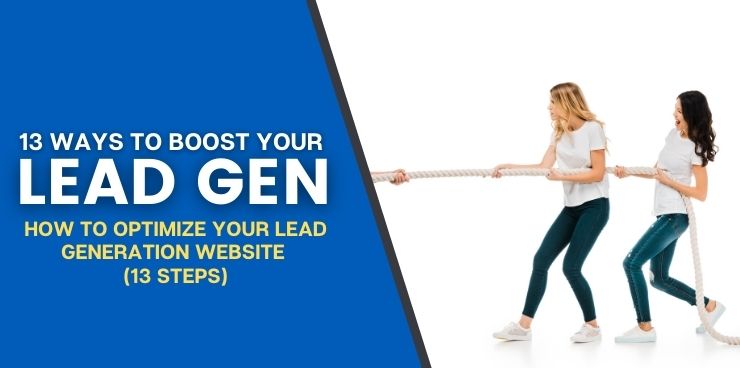Business begins during the lead generation process. In the age of digital marketing, that means attracting the right people to your website through search engine optimization (SEO). SEO helps potential customers find your website and product(s) from search engines such as Google and Bing.
Your website acts as an advertisement for your products and services. To focus on a good lead generation website, your web design should focus on product marketing. The more traffic your website receives, the more sales your company will make.
 Steps in Optimizing Your Lead Generation Website
Steps in Optimizing Your Lead Generation Website
To get the traffic that your business needs, your website should be geared toward lead generation. These 13 easy steps will help you generate more leads specifically from your target audience.
Step 1: Start with a Basic CTA on Your Homepage
Your homepage acts as the anchor for your entire website. Leads often try to find the homepage if they choose to go dive deeper into your website past the landing page. And in many cases, the homepage will act as your landing page by itself. Therefore, you need to have a call to action (CTA) displayed prominently on your homepage.
With a basic CTA, you want to prompt the customer into performing the desired action. For example, most homepages will include something like “click here to browse our store.” You can also update this CTA based on current promotions, deals and offers. So, when a prospect lands on your homepage and sees “summer sale,” they’ll be more inclined to click the link.
Other basic CTAs could include a simple message about getting in contact with a representative. The homepage does not have to have anything over the top. A simple prompt for the lead to engage with your business will more than suffice.
Step 2: Add Forms to the Pages that Generate More Traffic
To collect contact information, include lead magnets throughout your website. Lead magnets prompt the lead to enter their personal information so that you’re able to continue the nurturing process. Forms help your business gather contact and demographic information from your leads.
Lead magnets work best on high-traffic web pages. You will often find forms on “contact” pages and homepages alike. Sometimes, a popup will open as soon as a lead lands on your homepage. Popup messages can either outright request an email address or take the lead to a longer form.
Forms can request as much information as you like. However, try to keep them limited and only collect the information you need. Too long of a form might scare some leads away.
Step 3: Measure the Performance of all Lead Generators
Check on your lead generators from time to time to ensure adequate performance. Many lead generation companies offer software that enables you to view website statistics. Additionally, many website builders include an analytics feature.
Getting a read on lead generator performance helps you determine where you need to improve. If a page does not generate as much traffic as you need it to, consider taking another look at it. Whenever you see a web page doing really well, try to emulate that success across your website. The more data you compare on every page, the better those pages can be.
Step 4: Focus on Each Step of the Lead Generation Process
A functioning website is key to success for your marketing strategy. Optimize the lead generation process by reducing friction along the conversion path. This path takes the customer from the landing page to the purchase or contact page. Many other web pages exist between these two.
Make sure the lead has a clear shot all the way to the final step. Link the appropriate pages together. For instance, a CTA asking a lead to learn more about a specific product should link to that product’s store page. One weak link in the chain can ruin the entire sales process and keep that lead from turning into a customer.
To begin the optimization process, have a specific goal in mind for each page. Knowing where you want the lead to go next helps you get them there faster.
Step 5: Offer Downloadable e-books From Your Blog Posts
The more information you can offer your leads, the better they will feel about making a purchase. However, too much information on a website can negatively impact your SEO rating. To avoid this, you can offer digital brochures in the form of downloadable e-books.
E-books contain more information than most web pages since you can make them as long as you want. Place download links on blog posts to capitalize on the attention of a reader. Additionally, request an email address to deliver the e-book. This helps you gather more contact information and can eventually lead to a sale through email marketing.
Wherever you decide to include an e-book, make sure it contains relevant information to the related product. A customer wishing to learn more about grills does not want to have to sort through useless information about sinks. You can create as many e-books as you’d like. In fact, the more you have, the more interest you will retain.
 Step 6: Implement a Live Chat Service for Customer Support
Step 6: Implement a Live Chat Service for Customer Support
Unfortunately, most businesses cannot reply to every single customer inquiry. Sometimes, you may lack the necessary staff or the requests can come after business hours. A live chat service helps customers in a limited capacity, giving your sales teams the ability to direct their focus elsewhere. Chatbots can help point leads in the right direction and offer basic information.
Chatbots usually open with something like, “What is it you are looking for?” If the lead responds, the chatbot will then direct the lead to the appropriate web page. This helps your leads more easily navigate your website and greatly reduces friction.
In addition to chatbots, have a live representative help out customers as needed. This creates a more personable experience and makes each lead feel better served. While chatbots assist with basic website navigation, live chat reps can answer more specific customer inquiries. This greatly increases your customer service satisfaction.
Step 7: Personalize Your CTAs
A general CTA on your homepage is an effective way for customers to get the gist of what your business offers. However, more personalized and specific CTAs prompt customers to take specific actions. Consider customizing your CTAs in one of two ways.
One way is to create a specific CTA based on each blog post and product. This helps the customer connect with the blog copy on a deeper level. It shows them how they can apply what they just read about in a physical way. In short, it helps make the blog post feel more real.
The other type of personalized CTA focuses on the individual customer. For this method, your business needs to have at least some information about the customer in mind. The more you know about the customer, the more personal the CTA. Include this personal CTA in an email addressed to the specific customer.
Step 8: Nurture Your Leads
The more leads you attract, the better. However, if those leads do not convert into customers, your process is failing. Set up a lead nurturing process that helps guide each lead down the marketing funnel. Gathering some sort of contact information before the lead makes a purchase greatly assists the lead nurturing process.
Using this contact information, continue your marketing strategy beyond your website. Send the lead personalized offers based on their interest and browsing history. A simple email from time to time will keep you top of mind with the lead when they decide they need your product or service.
Many leads will need to visit your website a few times before they actually make a purchase. Nurturing those leads keeps them coming back for that inevitable purchase.
Step 9: Display Contact Information
Give all leads the appropriate information to get in contact with your business. Not only should you have a specific “contact” page, but you should also include links to that page throughout your website. You should also include your customer service email address on just about every page of your website. When a customer wants to get in contact with you, you need to make it easy for them to do so.
How you want customers to contact you depends on your business setup. Emails allow for better sorting of inquiries but take longer to respond to. Phone numbers allow for a more direct and immediate response but require more resources.
Figure out which method your business can support. If you decide to have a phone number, always include an email address as well. The more contact methods you deliver, the better you’ll be at satisfying your customers.
Step 10: Use Photos and Testimonials to Increase Credibility
Leads will usually want to see that you are selling before they decide to make a purchase. Put photos of your products and services on the correct pages to help leads visualize what they will receive. Photos go a long way towards making your website appear more legitimate.
Including testimonials from satisfied customers also really helps build trust. If you offer an excellent product, offer a review section so that customers can share their good experiences. Even negative reviews offer insight into how you can improve your product and business as a whole.
Step 11: Create Videos That Speak to the User
Videos work especially well at capturing a lead’s attention and giving them a good amount of information. Consider creating videos based on specific products. They can detail the specific uses and features of the product as well as show how the product came to be.
Create videos as traditional advertisements or offer a more infomercial kind of content. There are hardly any limits to the kind of videos you can create for your products. Just make sure that they have a unique message and truly speak to each lead. A video message from a business owner helps customers put a face to each product and service.
Step 12: Implement Power Words in Offer Description
Power words help customers feel more connected and pulled towards your offer. Instead of saying “feel more rested,” use phrases like “take your sleep back.” These kinds of phrases are hot buttons that make the lead feel more empowered by your product or service.
Avoid using passive language and include copy that yells rather than whispers. Tell the customers exactly what your product delivers and what they cannot get without it. Sprinkle these power words into product pages, advertisements and blog posts. Wherever you incorporate copy, include power words.
Step 13: Test!
After creating any web page, you should perform extensive tests on it. First and foremost, test it for readability, broken links and appropriate message. From there, test its performance to make sure it gets you the results you need. Perform A/B testing to compare two versions of the same site.
A/B testing directly compares two web pages to see which one leads prefer. Implement the web page that delivers the highest conversion rate. Once you have a website in place, continue testing it well beyond its launch date. The optimization process does not stop once you launch a page. Even your best-performing sites can use the occasional update to make them even better.
Optimize Your own Sales Process
Get the most out of your lead generation website with help from Selling Revolution. We help our clients increase leads, improve their sales process and recruit top talent. No matter your industry or experience level, Selling Revolution is here to help you improve your bottom line.
Schedule a no-obligation 20-minute introductory phone call today. The sooner we get to know you, the sooner you can start revolutionizing your lead generation process!


 Steps in Optimizing Your Lead Generation Website
Steps in Optimizing Your Lead Generation Website Step 6: Implement a Live Chat Service for Customer Support
Step 6: Implement a Live Chat Service for Customer Support